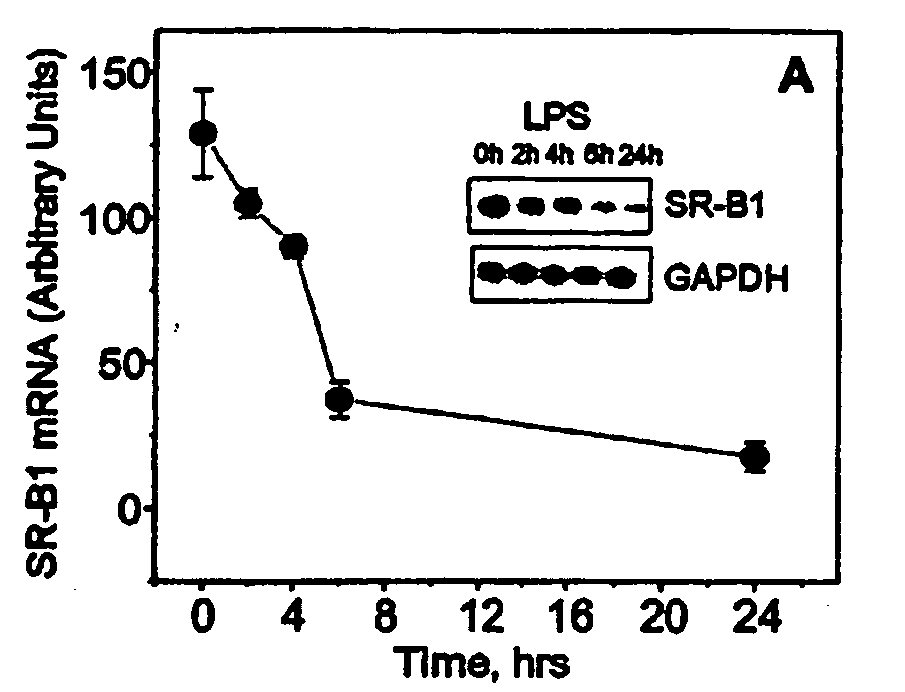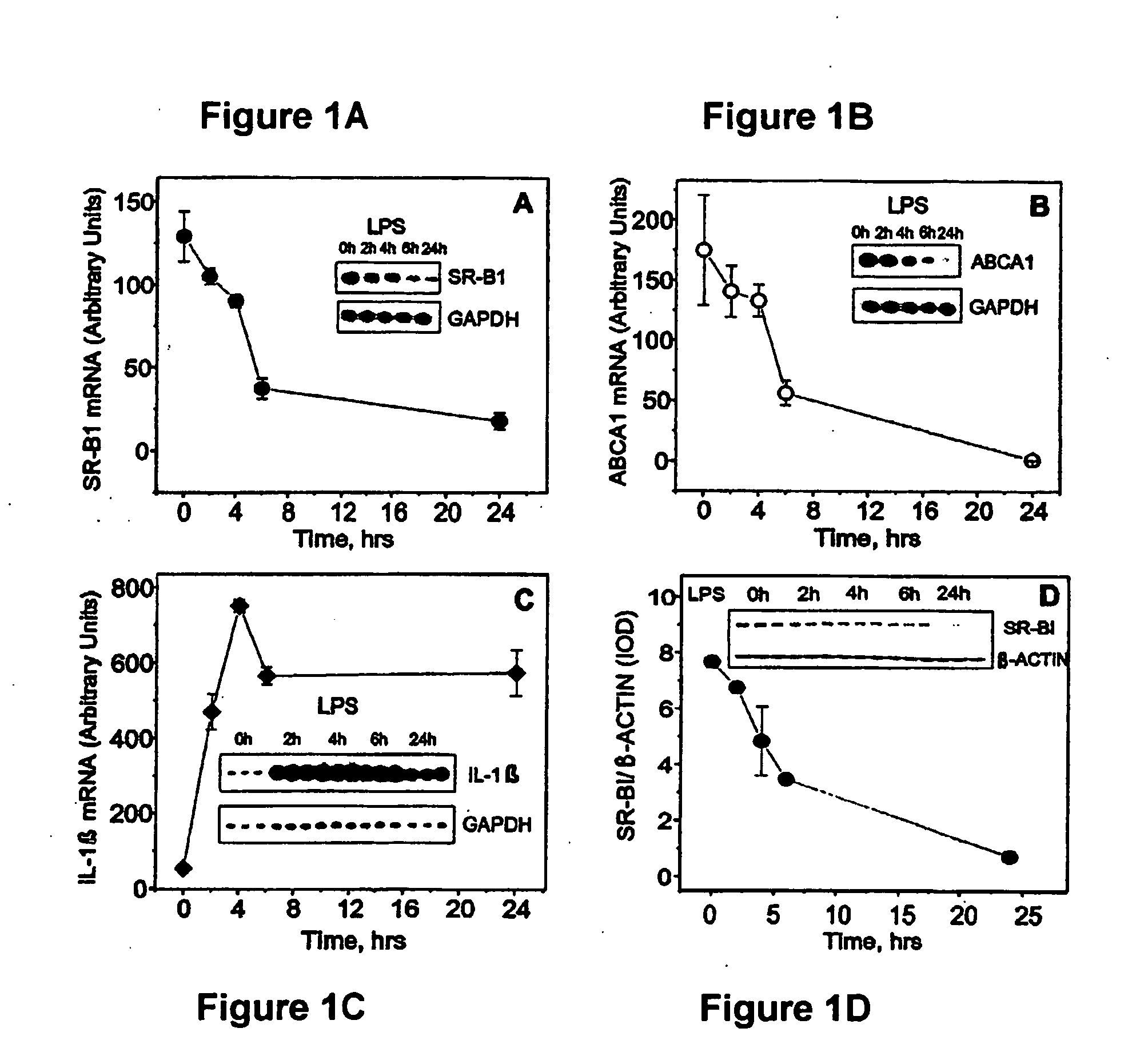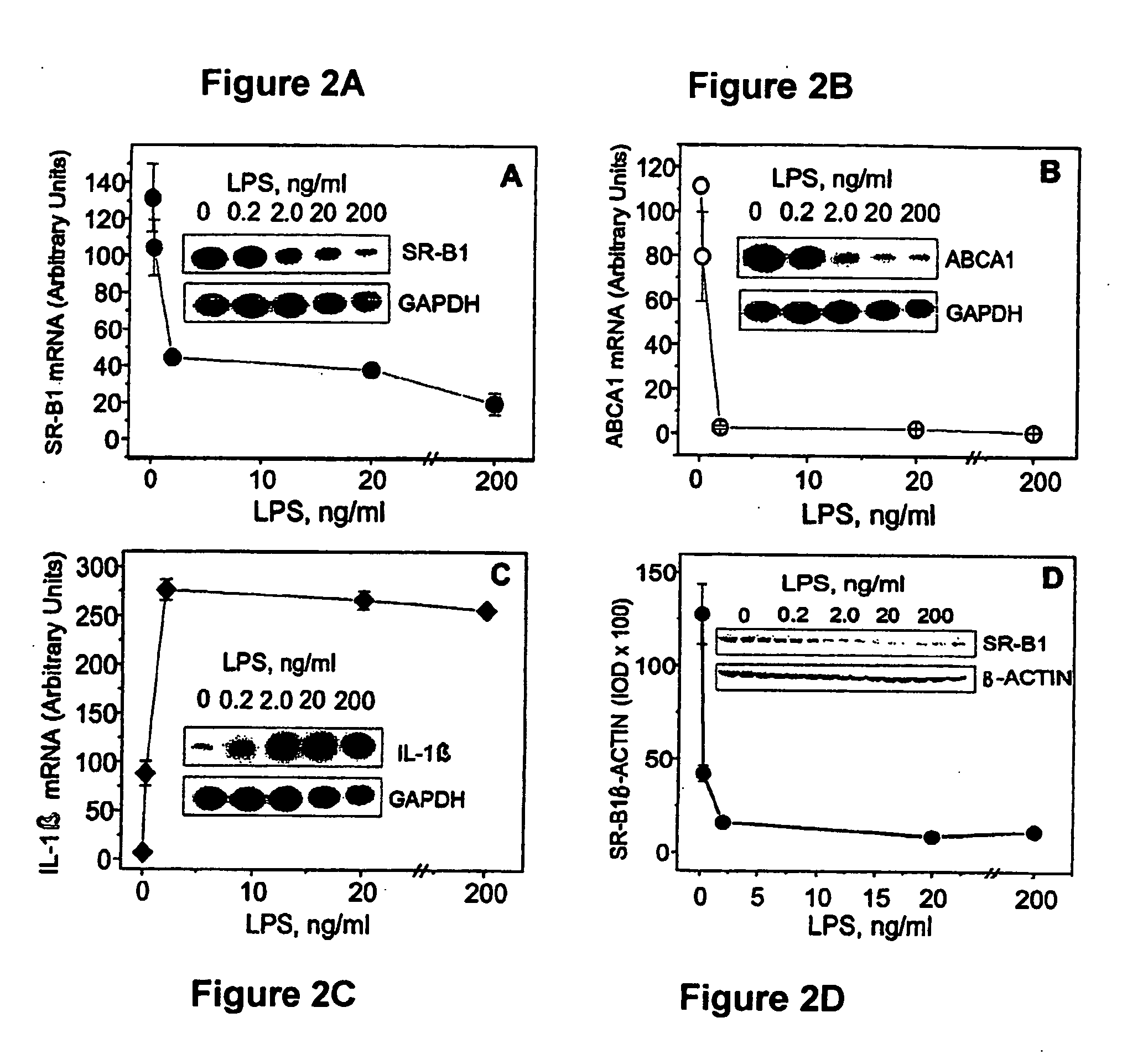Scavenger Receptor B1 (Cla-1) Targeting for the Treatment of Infection, Sepsis and Inflammation
a sepsis and inflammation-targeting technology, applied in the field of sepsis, inflammation or infection, can solve the problems of provoking an overwhelming inflammatory response and little insight into the abnormal cholesterol metabolism in the lesion si
- Summary
- Abstract
- Description
- Claims
- Application Information
AI Technical Summary
Problems solved by technology
Method used
Image
Examples
example 1
Lipopolysaccharide Down Regulates Both Scavenger Receptor B1 And ATP Binding Cassette Transporter A1 In RAW Cells
Materials and Methods
[0110]Cell culture and treatment. RAW 264.7 mouse monocyte-macrophages (ATCC TIE 71) are grown in 12-well plates in Dulbecco modified Eagle medium (DMEM) supplemented with 10% fetal bovine serum, penicillin (100 U / ml), and streptomycin (100 μg / ml) in a humidified atmosphere containing 5% CO2 and 95% air at 37° C. The experiments are carried out on the confluent monolayers in serum-free DMEM. Cells are treated with the following LPS preparations at 10 ng / ml for 24 h: full-length LPS from Escherichia coli serotype 0111:B4 (Sigma Chemical Co., St. Louis, Mo.) or Re595 mutant LPS, diphosphoryllipid A (DPLA), or monophosphoryllipid A (MPLA) (from Salmonella enterica serovar Minnesota; Sigma Chemical Co.). The serine protease inhibitor tosylphenyl chloromethyl ketone (TPCK) or tosyllysyl chloromethyl ketone (TLCK) (Sigma Chemical Co.) was added to the cells...
example 2
Binding and Internalization of Lipopolysaccharide by CLA-1, A Human Orthologue of Rodent Scavenger Receptor B1
Materials and Methods
[0133]Lipopolysaccharides, E. Coli B4:0111, Salmonella minnesota Re 595, Diphosphoryllipid A (DPLA) and Monophosphoryl lipid A (MPLA) are purchased from Sigma. Lipopolysaccharides from E. coli K12 strain LCD25 (unlabeled and 3H-metabolically labeled) were purchased from List Biological Laboratories. Rabbit anti-SR-BI / CLA-1 antibody cross-reacting with the human homologue CLA-1, is from Novus Biological.
[0134]Raw Cells. Mouse monocyte-macrophages, RAW 264.7 (ATCC [American Type Culture Collection] TIB 71), are grown in 12-well plates in Dulbecco modified Eagle medium (DMEM), supplemented with 10% fetal bovine serum (FBS), penicillin (100 U / ml), and streptomycin (100 μg / ml) in a humidified atmosphere containing 5% CO2 and 95% air at 37° C.
[0135]CLA-1 Overexpression HeLa cells. HeLa (Tet-off) cells (Clontech, Pal Alto, Calif.) are grown in DMEM (Invitrogen)...
example 3
Synthetic Amphipathic α-Helical Peptides Mimic of Exchangeable Apolipoproteins Block LPS uptake and LPS-Induced Proinflammatory Cytokine Response by THP-1 Monocyte Cells
[0176]Lipopolysaccharides (LPS) are proinflammatory bacterial cell wall components implicated in the pathogenesis of gram-negative sepsis and septic shock. The Examples provided above demonstrate that human scavenger receptor class B type I (CLA-1) mediates LPS-binding and internalization in overexpressing HeLa cells. Since the major recognition motif in SR-BI / CLA-1 ligands is an amphipathic α helix, the purpose of this study was to analyze the effects of synthetic peptides, which mimic anti-atherogenic exchangeable apolipoproteins, on LPS-uptake and LPS-stimulated cytokine production in HeLa and THP-1 cells, respectively. The L-37PA peptide which contains two class A amphipathic a-helices linked by proline efficiently competed against iodinated LPS in both mock transfected and CLA-1 overexpressing HeLa cells. A 100-...
PUM
| Property | Measurement | Unit |
|---|---|---|
| molecular weight | aaaaa | aaaaa |
| concentrations | aaaaa | aaaaa |
| concentrations | aaaaa | aaaaa |
Abstract
Description
Claims
Application Information
 Login to View More
Login to View More - R&D
- Intellectual Property
- Life Sciences
- Materials
- Tech Scout
- Unparalleled Data Quality
- Higher Quality Content
- 60% Fewer Hallucinations
Browse by: Latest US Patents, China's latest patents, Technical Efficacy Thesaurus, Application Domain, Technology Topic, Popular Technical Reports.
© 2025 PatSnap. All rights reserved.Legal|Privacy policy|Modern Slavery Act Transparency Statement|Sitemap|About US| Contact US: help@patsnap.com



